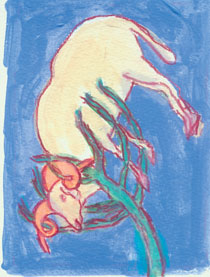Issue Archive
Commentary: Have a Reasonably Happy New Year

Hag sameah. Oops! Sorry for that. Though the contemporary custom for Rosh Hashana is to don new apparel, as if for a full-fledged festival, this somewhat undermines a sense of awe (Mishna Berura 51:25).
Traditionally, our garb should be dignified, white, but not “our finest.”
After all, although the onset of the new year in the Hebrew month of Tishrei tastes and smells like a holiday, its apples and honey mask some of our darkest apprehensions: Our very lives will get weighed in the balance. No wonder in times past some Jews held to the custom of a partial fast on this, our most indeterminate holy day.
Halfway across the year, in Israel, on the eve of Yom Ha-Zikaron (Remembrance Day for fallen soldiers), as on Rosh Hashana, skies are rent by the sound of the shofar. Then, not without a jolt, quavering sirens slide into Yom Ha’atzma’ut. So, too, is Rosh Hashana heralded by a parallel sequence: First there is somber thought, then a measured buoyancy.
On Rosh Hashana, poised between the unalterable and the unfathomable, we peer ruefully down the twisting pathways toward our secret deeds. At the same time, we celebrate the ongoing creation of the universe and look confidently to the future. The shofar embodies a day encompassing these contradictions. Apples and honey may anticipate fruitfulness and a clean slate. Yet even when mutely beheld at arm’s length, the shofar spirals into convolutions with inner depths that resonate but, save by the Almighty, are incapable of being fully sounded.
The shofar, then, imparts paradoxical meanings. On the one hand, it is associated with the Day of Judgment and going to battle:
“When you are at war in your land against an aggressor who attacks you, you shall sound the teru’a on the trumpets…” (Numbers 10:9).
It is also allied to joy:
“Happy is the people who know the sound of the trumpet” (Psalms 89:16).
With the exception of the cow, irremediably linked to idolatry in the desert, the shofar may be fashioned from the horn of any animal. In actuality, because of the ram’s role in the saving of Isaac—part of the Torah reading for the second day of Rosh Hashana—the horn of the ram is the most poignant and meaningful. And not for us alone. To the collective merit of our people, the shofar is said to help God remember Abraham’s binding of Isaac. For once the ram gets snared in the thicket, the Divinely instigated plot swiftly unfolds: The ram replaces Isaac as a burnt offering.
The Talmud equates both the blast of the teru’a and the shofar’s staccato jabs with sobs that issue from the inner depths of despair. Although on etymological grounds sounds link the wailing shofar to the tears of the mother of Sisera, it would surprise me if the shofar blasts recall this mother of an archenemy (who cried when she heard her son was dead) of the Jewish people for even one Jew in a thousand. In fact, are not Sisera’s mother as well as Hagar, about whom we read on this day, both surrogates for the mother of Isaac, who is so conspicuously absent from the biblical text on the day her beloved son is led away? The muffled sobs of Sarah, unnoted but surely not unheard, are subsumed by the blast of the shofar.
After the ram replaces Isaac, an angel renews God’s promise: “And through your seed all the nations of the earth will be blessed, because you obeyed My voice.” But the voice of Sarah never again is heard in the biblical narrative. If only for her pain, Rosh Hashana cannot beget an unalloyed hag sameah.
G’mar hatima tova.
Haim Chertok is a writer living in Israel whose latest book is He Also Spoke as a Jew: The Life of James Parkes (Vallentine Mitchell).










 Facebook
Facebook Instagram
Instagram Twitter
Twitter
Leave a Reply